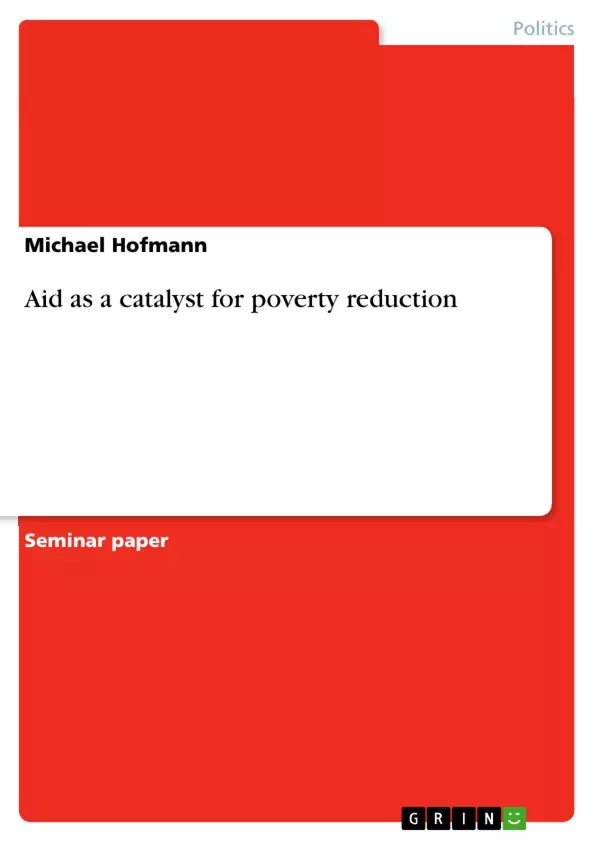ntroduction
The underdevelopment of the African continent and the multi-layered causes of this problem have been central to various plans and frameworks aimed at finding a way out of the vicious circle of poverty, poor governance, indebtedness and lack of resources. From efforts in the 1980s to more recent initiatives1, the African countries were mostly perceived as the problem children of international development policies. Besides these specifically Africa orientated development frameworks, a number of global programmes were launched in order to approach the problems faced by Least Developed (LDC) and often Heavily Indebted Poor Countries (HIPC). Examples are the HIPC Initiative (1996) supported by the IMF and World Bank, and the formulation of the Millennium Development Goals (MDGs) in September 2000.
By releasing its report2 in March 2005, the Commission for Africa, set up by Britain’s Prime Minister Tony Blair, added another plan to the already exiting ones. The appointment of the commission was due to the fact that the Millennium Development Goals that have to be reached until 2015 are likely to be missed. Assuming the presidency of both, the EU and the G8 summit in 2005, the British government saw itself in a good position to advance decisively international development policies towards Africa. Cornerstones of the report are 100 per cent debt cancellation for sub-Saharan African countries “which need it”,3 additional $25 billion a year in aid provided by donor countries by 2010 and a further increase of $25 billion a year by 2015.4
These are only some of the objectives outlined by the commission’s report but they constitute the main pillars concerning the immediate economic intents. One has to point out that the main prerequisites for an effective implementation of the plan’s proposals are adjustment processes related to African institutions. Institutional deficiencies on the recipients’ side are a problem that has to be considered as being crucial. The lack of home-grown institutional competence5 and basic institutions of accountability6 respectively are some aspects that point to the shortcomings of recipient’s capacity to manage an increase in money inflow wisely. [...]
Inhaltsverzeichnis (Table of Contents)
- Introduction
- Main Proposals of Blair's Commission for Africa
- Classifying the Proposals of the Commission for Africa
- Increased Financial Aid and Poverty Reduction
- The Relation between Aid and Poverty Reduction
- Requirements for a Positive Correlation between Aid and Poverty Reduction
- Does Africa Meet the Institutional Requirements?
- Conclusions
Zielsetzung und Themenschwerpunkte (Objectives and Key Themes)
This essay argues that increased financial aid transferred within a rather short period of time, as proposed by the Commission for Africa, is not able to enhance African economic development considerably enough to have an impact on poverty reduction. The essay assesses the general chances of success for the effective usage of increased financial aid in African economies.
- Evaluating the effectiveness of increased financial aid as a catalyst for poverty reduction in Africa.
- Analyzing the main proposals of the Commission for Africa, particularly debt cancellation and increased aid.
- Exploring the relationship between aid and poverty reduction and the requirements for a positive correlation.
- Assessing the institutional capacity of African countries to effectively manage increased financial inflows.
- Examining the underlying development concepts inherent to the Commission's report, specifically the Washington Consensus.
Zusammenfassung der Kapitel (Chapter Summaries)
- Introduction: The essay introduces the problem of African underdevelopment and its multifaceted causes, highlighting various international development efforts including the HIPC Initiative and the Millennium Development Goals. It then focuses on the Commission for Africa's report and its key proposals, particularly debt cancellation and increased aid. The importance of institutional capacity building in recipient countries is emphasized.
- Main Proposals of Blair's Commission for Africa: This section outlines the Commission's main proposals, including the goal of achieving a 7% annual growth rate by 2010 to halve poverty by 2015. The report's 89 policy recommendations across various fields are briefly introduced, with a focus on the core recommendations related to economic development, namely debt cancellation and increased aid.
- Classifying the Proposals of the Commission for Africa: This section analyzes the underlying development concepts of the Commission's report, primarily focusing on the Washington Consensus approach. The Washington Consensus emphasizes the need for a specific set of economic policy measures to trigger development, including fiscal discipline, trade liberalization, and privatization.
- Increased Financial Aid and Poverty Reduction: This section delves into the relationship between aid and poverty reduction, examining the requirements for a positive correlation. It discusses the importance of institutional capacity building and the potential challenges of managing increased financial inflows. The section also explores whether African countries meet the institutional requirements for effective aid utilization.
Schlüsselwörter (Keywords)
This essay focuses on the politics of international development, specifically examining the effectiveness of increased financial aid as a catalyst for poverty reduction in Africa. Key themes include the Commission for Africa's report and its proposals, debt cancellation, increased aid, the Washington Consensus, institutional capacity building, and the relationship between aid and poverty reduction.
- Quote paper
- Michael Hofmann (Author), 2005, Aid as a catalyst for poverty reduction, Munich, GRIN Verlag, https://www.grin.com/document/61991



